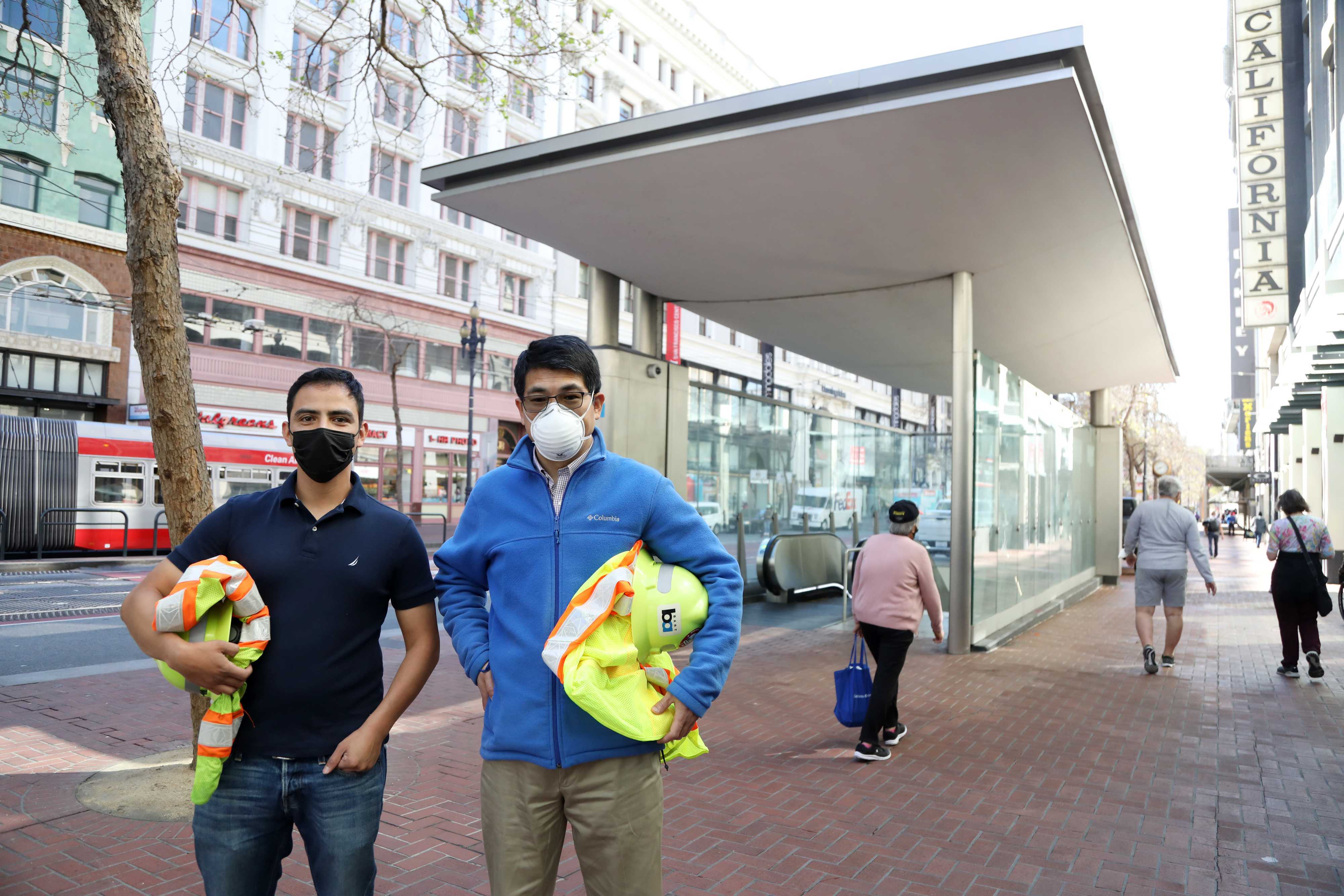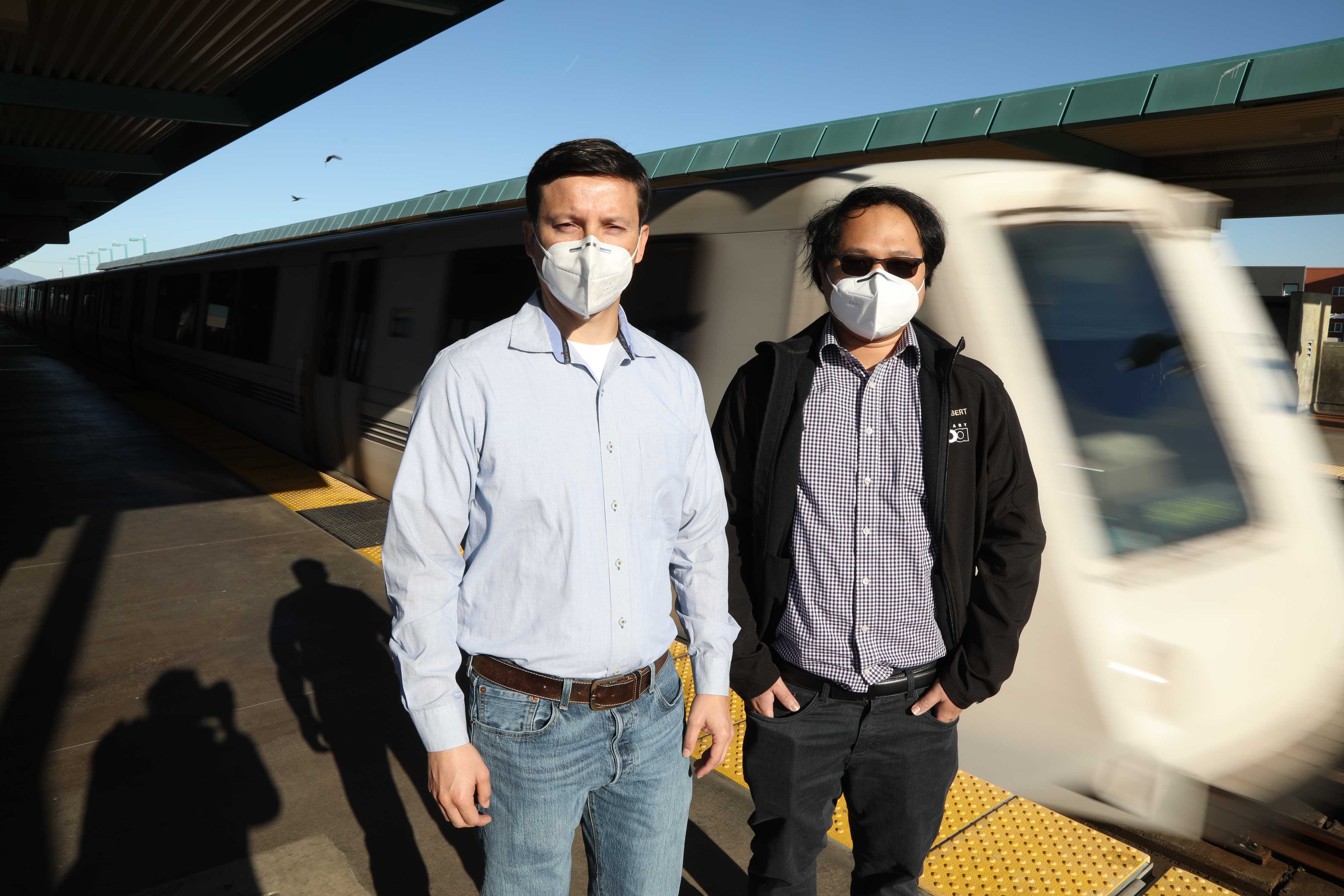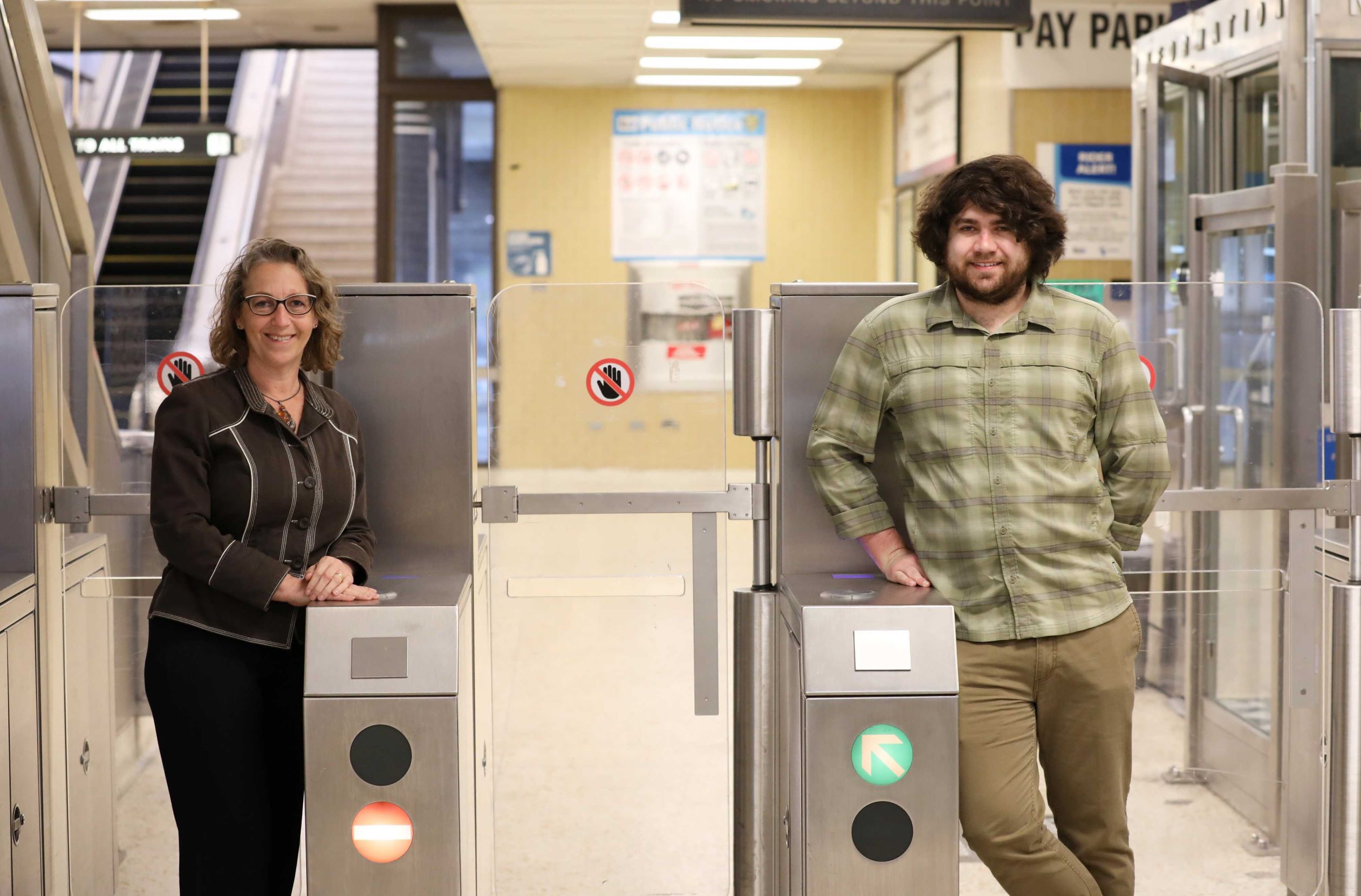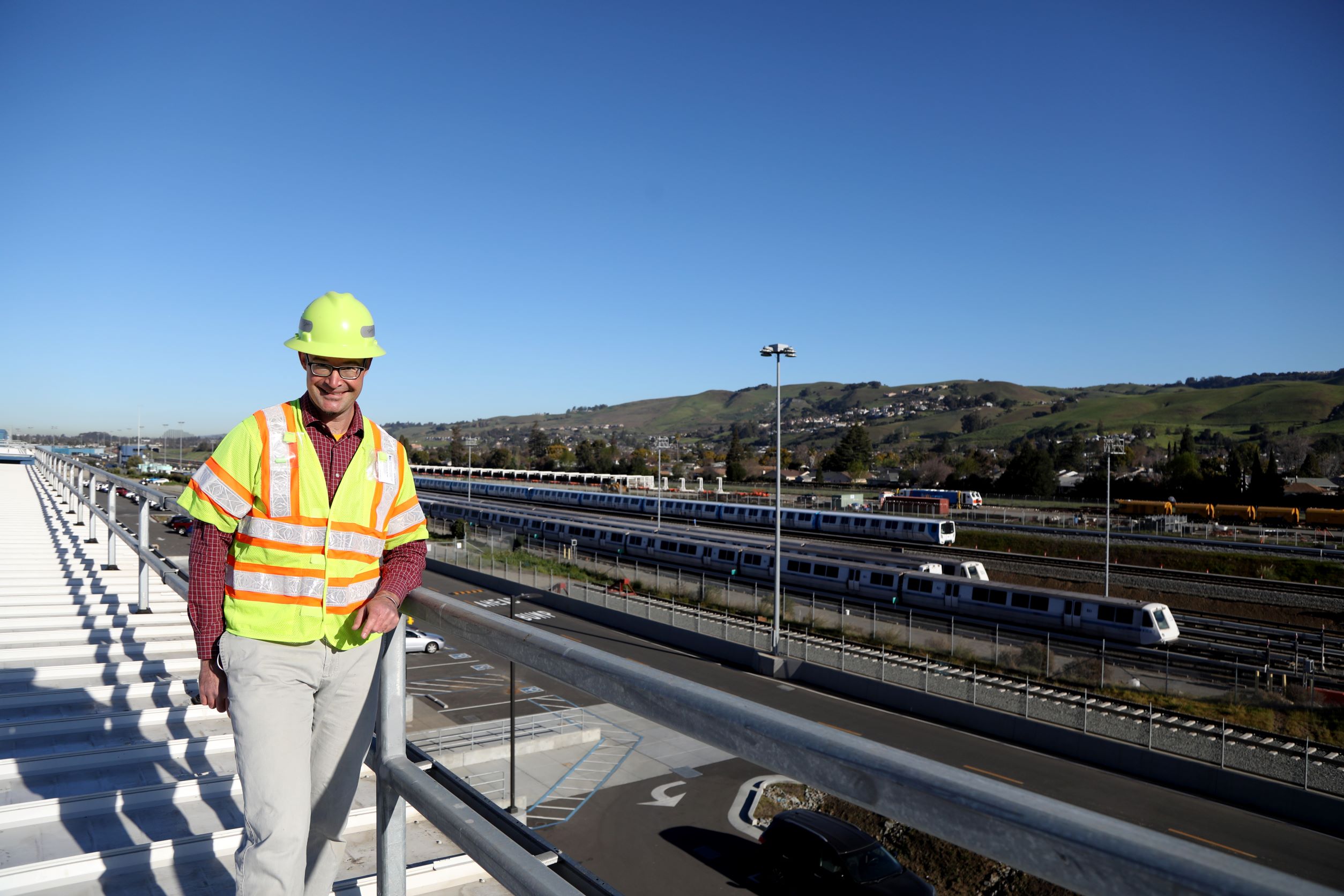National Engineers Week 2022: BART engineers go the distance to innovate BART and prioritize rider safety
In celebration of National Engineers Week from February 21-26, 2022, BART Communications interviewed four engineering teams working on a project which is and will significantly improve BART. BART has hundreds of engineers working to improve the system and the rider experience mostly hidden from public view. With the annual National Engineers Week, we are shining a light on their well-deserved recognition.
BART is currently hiring engineering positions for applicants interested in improving BART and help move the Bay Area. Please visit bart.gov/jobs or click here to see specific engineer job listings open as of publishing time.
BART mechanical engineer Samuel Hoffman poses atop a structure at Hayward Maintenance Complex.
Samuel Hoffman, Principal Mechanical Engineer: Power & Mechanical Engineering
Sam Hoffman is dreaming of pipes. Or, perhaps more accurately, engineering a replacement of the water pipes at the Hayward Yard, BART’s largest train yard that is located next to a new maintenance complex.
Hoffman, a mechanical engineer, was tasked with planning how BART can best and most efficiently replace pipes and fire hydrants installed in the late 1960s, when BART was being built, and bring them up to 21st century standards.
Plumbing has never been a sexy topic (Sam may disagree), but for BART, a new water distribution system can be a game-changer. BART relies on a lot of water at the yards, mainly to wash the exterior and interior of train cars in service after a long day out in the system. It also needs water in case of fire emergencies.
Perhaps most importantly, Hoffman noted, the pipe replacements and upgrades need to be completed with minimal impact to Yard and Mainline operations.
“Everything this project touches could make our Transportation, Maintenance or Shops folks unhappy as it can interrupt their work,” said Hoffman. “We need to make sure this is well-coordinated…especially now that a Contractor is on board to execute project work.”
Hoffman notes that many of the old pipes are in good condition; a challenge is that many of those pipes are asbestos-reinforced concrete, and that may result in them being abandoned in place rather than removed. When the cast iron pipes (another common pipe material from that era) fail, the detection and repairs can take several days and tens of thousands of gallons could be lost by the time repairs are completed. Excessive leakage is not only wasteful and costly, but presents risks to nearby structures, foundations, tracks or roads.
The new pipes are constructed with polyvinyl chloride (PVC) which is durable and much less likely to crack and fail. The PVC pipe replacements also can withstand high water pressures, which will be acceptable to the local Fire Department and for Maintenance users. More sensitive flow monitoring and additional valves will allow for better control if and when leaking occurs.
As California may face repeated droughts, Hoffman touts water resiliency and efficiency as key benefits to the new pipe upgrades.
“You hear, ‘they don’t make them like they used to’, but that doesn’t really apply to these pipes,” said Hoffman. “The original pipes had a lifetime of 25-30 years, and have served for 50. These PVC pipes should last 50 years at a minimum, and probably will last for 100 years, and should be easier to repair if needed. BART will be able to use these new pipes into the next century.”

Carlos Rosales, left, and Shihua Nie, right, poses in front of the Powell St. Station canopy. Rosales and Nie are part of structural engineering preparing BART for the "Big One" earthquake in the Bay Area.
Shihua Nie, Principal Structural Engineer: Structural Engineering; Carlos Rosales, Engineer: Structural Engineering
For Shihua Nie and Carlos Rosales, earthquakes are a part of reality in the Bay Area. With that given, the engineers are part of a larger team who are making sure BART can continue to be resilient in the prospect of “The Big One.”
Nie and Rosales, both structural engineers at the Civil/Structural/Construction Engineering Group, help in a suite of projects for earthquake resiliency at BART. One half of earthquake resiliency is focused on making sure BART can stay ahead of earthquakes. BART’s pioneering Earthquake Early Warning System has been in effect for several years, which allows trains to automatically slow down and stop for inspections when seismic activity is detected near BART’s system. The Earthquake Early Warning System is powered by ShakeAlert data run by U.S. Geological Survey, which have sensors around the Bay Area and California.
Nie and Rosales believe what happens after earthquakes is as important as alerting just before an earthquake. Both lead dozens of BART engineers in the Post Earthquake Emergency Response Teams, whose job right after a major earthquake is to check structures in the BART system. The Emergency Response Team hold a drill every year to refresh staff what and how to inspect the structures.
“When a major earthquake happens, there are two teams which spring into action: one on Engineering side and one of Maintenance side,” said Nie. “For Engineering side, we will be inspecting the structures from where we have access, like at stations and at aerial structures or bridges.”
Nie and Rosales’ team is also working to integrate USGS data to locate possible earthquake damage more efficiently in the BART system. Using ShakeCast data from USGS, an internal BART algorithm predicts the possible infrastructure damage states – to alert frontline crews which assets may be damaged during earthquake.
“USGS’s output becomes our input,” said Rosales. “We will take the ShakeCast data and the as-built conditions of our infrastructure to predict potential damages states. This information could be used to best inform the deployment of our engineering and maintenance personnel.”

Carlbert Fuertes, right, and Cesar Lopez Servin, left, poses at West Oakland BART station platform. Fuertes and Servin are part of the emergency generator team, one of the most complex engineering projects at BART.
Mohamad Fararjeh, Project Manager: Strategic Engineering; Carlbert Fuertes, Engineer: Power & Mechanical Engineering; Cesar Lopez Servin, Contractor: Maintenance and Engineering
Mohamad Fararjeh leads one of the most important engineering work at BART which most will never know – and hopefully one BART will never have to see applied in full.
Fararjeh leads a team of BART engineers and contractors to prepare the system for possibly its worst-case scenario: a major earthquake in the Bay Area and trains getting stranded without power in the Transbay Tube. Fararjeh’s team leads the construction, integration and implementation of a emergency generator project to offer a special power source for the Transbay Tube to be activated to provide sufficient power for evacuation and rescue of passengers trapped in the Transbay Tube.
The work is not limited to simply installing a generator; it requires upgrading many existent infrastructure – electrical, train control, hardware, software and others – to allow the generator to feed power where it needs to go. The work involves upgrading transformers, control systems, transfer switches, and many other parts located above ground and underground on both sides of the San Francisco Bay.
“It is a very complicated project,” Fararjeh says. “It might be one of the most complicated projects our engineers are working on right now.”
For engineers in the team, the emergency generator project has been a mountain climb-like exercise. The team continuously face one uphill climb after another and needs to become highly resourceful and collaborative to make progress. Due to the scope of engineering skills required for this project, the team says they’ve seen their skillset grow very quickly.
“When I joined this project I thought, looking at the complexity and type of work we’ll need to do, it’s just amazing,” said Fuertes, a Power & Mechanical Engineer at BART. “It’s not always you got to see a system like BART. There are parts in the system which is already established and just need updates and replacements. This project is something wholly different which all of our team members can bring something new to a sophisticated issue.”
Due to the complexity of the projects, contractors like Cesar Lopez Servin are involved in the project to provide expertise. But they are also given opportunities to learn and growth as engineers with BART.
“I’ve been on this project for two years now and it has allowed for so much personal and professional growth,” said Lopez Servin. “If you are up to the challenge at BART, people at BART allow you to work on things you haven’t worked on before and further develop your skills as an engineer.”
As Bay Area residents and BART riders, the three engineers understand there are many questions about what and how much the Transbay Tube can withstand in case of “The Big One” but assured there are many protocols in case to make sure all riders can be accounted for as best as possible. Fararjeh emphasized rider safety and preservation of life in case of a major disaster as a motivator in his leadership and his task as an engineer.
“I cannot put a price on a human life, but if I can save one life, I will spend millions of dollars if I had to,” said Fararjeh. “It’s worth it no matter what. A human life is always worth saving.”

Wendy Wheeler, left, and Jeffrey Martz, right, pose next to the Rockridge Station fare gates. Wheeler's Computer System Engineering team is helping develop new fare gates for BART in addition to their work in Digital Transformation.
Wendy Wheeler, Manager of Computer Systems Engineering; Herbert Diamant, Principal Computer Systems Engineer; Jeffrey Martz, Senior Computer Systems Engineer
For most of BART’s history, detecting a broken equipment in the trackway always required a set of human eyes to detect and confirm. But if Wendy Wheeler and her team of Computer Systems Engineering can have it their way, this practice would soon be a thing of the outdated past.
Wheeler’s team is leading the efforts of Digital Transformation, a systemwide effort to use data and machine learning to transform how BART manages its infrastructure. With more and more sensors and equipment with sensors feeding back data to its human operators, Digital Transformation aims to organize the data and communicate the data via dashboards.
“We’re trying to move away from being preventative to more predictive maintenance with our infrastructure,” said Wheeler. “We want to be smarter and quicker in responding to the devices before they experience issues or break down completely.”
Two departments have already benefitted from the Digital Transformation efforts already – and making a difference for BART riders. The first is for the traction power department who manages all circuit breakers in the system. Computer Systems Engineering created a dashboard to monitor all circuit breakers which updates every few seconds. Based on symptoms and past historical data, the department can deduce which equipment is nearing need of repair before it breaks down.
Maintenance departments have also seen benefits of Digital Transformation for errant weather conditions. For example, during rainy season, crews needed to be out in the system monitoring for malfunctioning sump pumps which will lead to flooding on the trackways. Using a dashboard with staff monitoring for symptoms of a degrading sump pump, crews can proactively repair pumps before or during a big rain event. Thanks to this proactiveness, train delays related to flooding have dropped to virtually zero in the past 2 year.
“Before, we used to deal with flooded trackways and service delays,” said Wheeler. “Now, we are algorithmically detecting faulty sump pumps and repairing before train service is impacted.”
With partnerships with UC Berkeley and University of San Francisco, engineering and computer science students have also been joining BART to find new Digital Transformation solutions to existent infrastructure problems at BART.
“It’s a long-term strategy, not just a project,” said Herbert Diamant. “We are bringing data-driven decision making to BART.”
Despite also designing and building physical machines visible at stations like fare gates and platform display signs (including a new color display sign at Lake Merritt Station), the team shared excitement at the potential of Digital Transformation. With internal departments working closer together and using better data to enhance decisions, they believe everyday riders experience will improve.
“The most exciting thing about this is the outreach,” said Jeffrey Martz. “When we have talked to our Maintenance and Engineering partners what kind of problems they are looking for, we realized it’s not a terribly hard problem for us to solve. That’s how we begin creating cool solutions. When I think about Digital Transformation, it’s about getting people thinking about what would be nice to have to better help BART. And it’s not far-fetched at all, because the pieces are already available.”
Join BART engineering to make your impact!
BART is looking for talented engineers who want to help solve complex challenges and help move the Bay Area.
To apply, please visit bart.gov/jobs and check out our Online Job Application Portal for future employees and current employees. You can search for job listings based on the four-digit ID number next to the job title in the portal.
Current full-time engineering positions we have open, as of February 22, 2022:
- Engineer (Electrical) - 9112
- Engineer (Mechanical) - 9111
- Principal Construction Engineer -9110
- Manager of System Integration (Core Capacity Project Delivery) - 9007
- Senior Vehicle Systems Engineer CBTC - 9033
BART's Civil/Structure/Construction Engineering Department is also looking for summer interns (ID: 9162). Application deadline, as of now, is March 18, 2022 (or upon receipt of 200 applications, whichever comes first).
This summer internship program is scheduled to run for eight (8) weeks beginning on June 20, 2022 and ending on August 12, 2022. All candidates selected must be able to attend the entire program. This position is located in Oakland, CA and does not have a remote work option.
